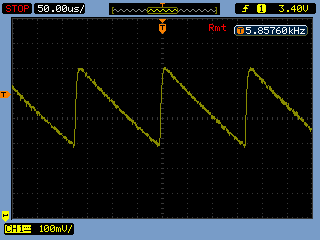This week I finally received my Bus Pirate v4 from Seeed Studio.
The first thing I did after opening the box was to probe the 3.3V rail with the BP internal power supply enabled.
Here’s what I saw:

That looks familiar! Except this time it’s an oscillation at 5.9kHz and 400mVpp! (almost 4 times what I saw on the SFE Bus Pirate).
I replaced C11 with a 4.7uF tantalum surface mount cap that I scavenged from another board, and the oscillation went away completely:

Ahh, that’s better!
Again, I strongly suspect the low ESR of the ceramic cap is to blame. The 3.3V regulator really needs to see the higher ESR of a tantalum or electrolytic cap for stability.
My advice to all Bus Pirate owners is to check your 3.3V rail with a scope, if possible, and replace C11 with a tantalum or electrolytic cap. Alternatively you may be able to add a small amount of resistance in series with the ceramic cap that comes with the Bus Pirate, but I haven’t verified this.

MIC5205 datasheet says:
The output capacitor should have an ESR (effective
series resistance) of about 5Ω or less and a resonant
frequency above 1MHz. Ultra-low-ESR capacitors can
cause a low amplitude oscillation on the output and/or
underdamped transient response. Most tantalum or
aluminum electrolytic capacitors are adequate; film types
will work, but are more expensive. Since many aluminum
electrolytics have electrolytes that freeze at about –
30°C, solid tantalums are recommended for operation
below –25°C.
I’ve checked my Logic sniffer from DP – 3v3 rail is stable inspite of single ceramic cap at its output, but 2v5 rail is oscillating 200mV peak-to-peak and 1v2 rail at 30mV peak-to-peak.